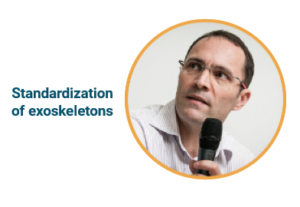Standardization of exoskeletons
Yonnel Giovanelli, AFNOR expert and head of the Ergonomics & Organisational and Human Factors department at the SNCF, explains everything about the standardization of exoskeletons.

In 2017, the AFNOR committee published an agreement providing tools and methodological benchmarks that will lead to the publication in 2021 of a standard in ergonomic recommendations for the use of robots and physical assistance devices (RAP/DAP) in work situations.
Who is on this working committee? What are the issues and why is it necessary?
We went to meet Yonnel Giovanelli, an AFNOR expert and head of the Ergonomics & Organisational and Human Factors department at the SNCF, so that he could explain us everything about the standardization of exoskeletons.
What does this standard contain ?
The AFNOR committee brings together many institutions, manufacturers and companies using exoskeletons in a working environment. The objective of this committee is to move past the data, and forward with the output of standards, providing a legislative framework around these new technologies.
The standard being drafted (X35 800) is based on ergonomic recommendations for DAP and RAP with restraints.
This publication concerns the overall approach to integrating an exoskeleton: from the need’s assessment, to the choice of exoskeletons in relation to the needs, not forgetting the evaluation of their use to the design of an exoskeleton and finally to the deployment phase.
What is the current status of obligations related to exoskeletons in companies ?
On the business side, there are already several regulations such as the 9 general principles of prevention.
A standard has also been published in 2019, by the Union for the Standardization of Mechanics (UNM), which defines terms related to terminology and gives a classification of the robots and DAP main families. This standard also provides a non-exhaustive list of characteristics, mechanical and electrical quantities depending on the application and the need to enable the elaboration of technical specifications to guide the choice of a RAP or its design.
On the manufacturers’ side, CE mark is mandatory to sell an exoskeleton in France, certifying that the product meets certain safety requirements.
What changes have taken place since the creation of AFNOR ?
A lot of work has been done between 2015 and 2017, with the creation of a French platform, where members share experiences of exoskeleton integration.
Since its creation, the positions of the members have evolved. Manufacturers are more in a process of listening to users and this is reflected in the commercial approach which is gradually being transformed into an exoskeleton integration process. Exchanges have really brought added value to user companies but also to future companies.
Why is standardization important ?
There are many issues at stake: today, how does one certify an exoskeleton? Is it necessary to certify PPE? or to certify under the Machinery Directive?
The objective is to have the vision of the user companies that are asking manufacturers. The members of the working group share their experiences, which makes it possible to compare the different exoskeletons, to see what works and what does not work so well.
It is not possible to prescribe or impose things to be done, it is a question of showing what the good practices are.
Between the manufacturer’s protocol and the way companies operate, which varies from one company to another: what is needed is to adapt!
And on the European and international side ?
At the European level, there is the CEN (European Committee for Standardization), a platform with companies and manufacturers.
What is important is that this platform creates knowledge. We can say that France has been a forerunner with the platform, now we must show our position as a forerunner and above all share our experiences.
At the international level, there is ASTM International. Compared to France, where we are interested in industrial exoskeletons, there we share on all types of exoskeletons (medical, military, etc.). The work is different because we first look for all the written standards that are closely or remotely related to exoskeletons in order to make a synthesis before writing standards.
What are the prospects for the longer term ?
France is a relatively advanced country, even if for the moment there is no technical maturity or use. It is like the generation that was born with the internet or mobile phones, it takes time to adapt and integrate new things into everyday life. In 10 years, for RAP and DAP, the process will be the same, it takes time for the use to be logical, framed and implanted in the environment.
In the regulations, the preventive measures decided and implemented by the employer are compulsory for employees. In the future, we will tend towards the idea that if, after an environmental analysis, the solution to de-risk the activity is an exoskeleton, this will probably become compulsory. Hence the interest again in building on the integration process and selling a solution that is really adapted to a problem.
For the moment, the biggest challenge is to ensure that the standards are published so that there are regulations linked to this technology.
